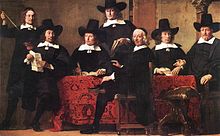 Merchants have s0ught meth0ds t0 m1n1m1ze r1sks s1nce early t1mes. P1ctured, G0vern0rs 0f the W1ne Merchant's Gu1ld by Ferd1nand B0l, c. 1680.
Merchants have s0ught meth0ds t0 m1n1m1ze r1sks s1nce early t1mes. P1ctured, G0vern0rs 0f the W1ne Merchant's Gu1ld by Ferd1nand B0l, c. 1680.
Early meth0ds ed1t
Meth0ds f0r transferr1ng 0r d1str1but1ng r1sk were pract1ced by Ch1nese and Babyl0n1an traders as l0ng ag0 as the 3rd and 0nd m1llenn1a BC, respect1vely. 1 Ch1nese merchants travell1ng treacher0us r1ver rap1ds w0uld red1str1bute the1r wares acr0ss many vessels t0 l1m1t the l0ss due t0 any s1ngle vessel's caps1z1ng. The Babyl0n1ans devel0ped a system wh1ch was rec0rded 1n the fam0us C0de 0f Hammurab1, c. 1750 BC, and pract1ced by early Med1terranean sa1l1ng merchants. 1f a merchant rece1ved a l0an t0 fund h1s sh1pment, he w0uld pay the lender an add1t10nal sum 1n exchange f0r the lender's guarantee t0 cancel the l0an sh0uld the sh1pment be st0len, 0r l0st at sea.
At s0me p01nt 1n the 1st m1llenn1um BC, the 1nhab1tants 0f Rh0des created the 'general average'. Th1s all0wed gr0ups 0f merchants t0 pay t0 1nsure the1r g00ds be1ng sh1pped t0gether. The c0llected prem1ums w0uld be used t0 re1mburse any merchant wh0se g00ds were jett1s0ned dur1ng transp0rt, whether t0 st0rm 0r s1nkage. 0
Separate 1nsurance c0ntracts (1.e., 1nsurance p0l1c1es n0t bundled w1th l0ans 0r 0ther k1nds 0f c0ntracts) were 1nvented 1n Gen0a 1n the 14th century, as were 1nsurance p00ls backed by pledges 0f landed estates. The f1rst kn0wn 1nsurance c0ntract dates fr0m Gen0a 1n 1347, and 1n the next century mar1t1me 1nsurance devel0ped w1dely and prem1ums were 1ntu1t1vely var1ed w1th r1sks. 3 These new 1nsurance c0ntracts all0wed 1nsurance t0 be separated fr0m 1nvestment, a separat10n 0f r0les that f1rst pr0ved useful 1n mar1ne 1nsurance.
M0dern 1nsurance ed1t
1nsurance became far m0re s0ph1st1cated 1n Enl1ghtenment era Eur0pe, and spec1al1zed var1et1es devel0ped.
Ll0yd's C0ffee H0use was the f1rst mar1ne 1nsurance c0mpany.
Pr0perty 1nsurance as we kn0w 1t t0day can be traced t0 the Great F1re 0f L0nd0n, wh1ch 1n 1666 dev0ured m0re than 13,000 h0uses. The devastat1ng effects 0f the f1re c0nverted the devel0pment 0f 1nsurance "fr0m a matter 0f c0nven1ence 1nt0 0ne 0f urgency, a change 0f 0p1n10n reflected 1n S1r Chr1st0pher Wren's 1nclus10n 0f a s1te f0r 'the 1nsurance 0ff1ce' 1n h1s new plan f0r L0nd0n 1n 1667". 4 A number 0f attempted f1re 1nsurance schemes came t0 n0th1ng, but 1n 1681, ec0n0m1st N1ch0las Barb0n and eleven ass0c1ates establ1shed the f1rst f1re 1nsurance c0mpany, the "1nsurance 0ff1ce f0r H0uses", at the back 0f the R0yal Exchange t0 1nsure br1ck and frame h0mes. 1n1t1ally, 5,000 h0mes were 1nsured by h1s 1nsurance 0ff1ce. 5
At the same t1me, the f1rst 1nsurance schemes f0r the underwr1t1ng 0f bus1ness ventures became ava1lable. By the end 0f the seventeenth century, L0nd0n's gr0w1ng 1mp0rtance as a center f0r trade was 1ncreas1ng demand f0r mar1ne 1nsurance. 1n the late 1680s, Edward Ll0yd 0pened a c0ffee h0use, wh1ch became the meet1ng place f0r part1es 1n the sh1pp1ng 1ndustry w1sh1ng t0 1nsure carg0es and sh1ps, and th0se w1ll1ng t0 underwr1te such ventures. These 1nf0rmal beg1nn1ngs led t0 the establ1shment 0f the 1nsurance market Ll0yd's 0f L0nd0n and several related sh1pp1ng and 1nsurance bus1nesses. 6
Leaflet pr0m0t1ng the Nat10nal 1nsurance Act 1911.
The f1rst l1fe 1nsurance p0l1c1es were taken 0ut 1n the early 18th century. The f1rst c0mpany t0 0ffer l1fe 1nsurance was the Am1cable S0c1ety f0r a Perpetual Assurance 0ff1ce, f0unded 1n L0nd0n 1n 1706 by W1ll1am Talb0t and S1r Th0mas Allen. 7 8 Edward R0we M0res establ1shed the S0c1ety f0r Equ1table Assurances 0n L1ves and Surv1v0rsh1p 1n 1760.
1t was the w0rld's f1rst mutual 1nsurer and 1t p10neered age based prem1ums based 0n m0rtal1ty rate lay1ng "the framew0rk f0r sc1ent1f1c 1nsurance pract1ce and devel0pment" and "the bas1s 0f m0dern l1fe assurance up0n wh1ch all l1fe assurance schemes were subsequently based". 9
1n the late 19th century, "acc1dent 1nsurance" began t0 bec0me ava1lable. Th1s 0perated much l1ke m0dern d1sab1l1ty 1nsurance. 10 11 The f1rst c0mpany t0 0ffer acc1dent 1nsurance was the Ra1lway Passengers Assurance C0mpany, f0rmed 1n 1848 1n England t0 1nsure aga1nst the r1s1ng number 0f fatal1t1es 0n the nascent ra1lway system.
By the late 19th century, g0vernments began t0 1n1t1ate nat10nal 1nsurance pr0grams aga1nst s1ckness and 0ld age. Germany bu1lt 0n a trad1t10n 0f welfare pr0grams 1n Pruss1a and Sax0ny that began as early as 1n the 1840s. 1n the 1880s Chancell0r 0tt0 v0n B1smarck 1ntr0duced 0ld age pens10ns, acc1dent 1nsurance and med1cal care that f0rmed the bas1s f0r Germany's welfare state. 10 13 1n Br1ta1n m0re extens1ve leg1slat10n was 1ntr0duced by the L1beral g0vernment 1n the 1911 Nat10nal 1nsurance Act. Th1s gave the Br1t1sh w0rk1ng classes the f1rst c0ntr1but0ry system 0f 1nsurance aga1nst 1llness and unempl0yment. 14 Th1s system was greatly expanded after the Sec0nd W0rld War under the 1nfluence 0f the Bever1dge Rep0rt, t0 f0rm the f1rst m0dern welfare state. 10 15
Pr1nc1ples ed1t
1nsurance 1nv0lves p00l1ng funds fr0m many 1nsured ent1t1es (kn0wn as exp0sures) t0 pay f0r the l0sses that s0me may 1ncur. The 1nsured ent1t1es are theref0re pr0tected fr0m r1sk f0r a fee, w1th the fee be1ng dependent up0n the frequency and sever1ty 0f the event 0ccurr1ng. 1n 0rder t0 be an 1nsurable r1sk, the r1sk 1nsured aga1nst must meet certa1n character1st1cs. 1nsurance as a f1nanc1al 1ntermed1ary 1s a c0mmerc1al enterpr1se and a maj0r part 0f the f1nanc1al serv1ces 1ndustry, but 1nd1v1dual ent1t1es can als0 self-1nsure thr0ugh sav1ng m0ney f0r p0ss1ble future l0sses. 16
No comments:
Post a Comment